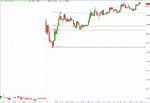FWIW, Socrates is correct about all of this, but it's not a matter of prescience but of understanding the interrelationships among demand and supply, buying pressure and selling pressure, support and resistance. If one is not aware of these things, he won't see them, just as one will have difficulty seeing things in the dark without night vision goggles.
Of course it can be done in real time. It has to be done in real time, though one ought to plot the S/R levels in advance. If I couldn't do it in real time, I couldn't trade. The question is not whether it can be done in real time or not but how to do it, and learning how to do it requires a certain "availability".
It's not at all unusual that these two should make exactly the same trades, if they did. I worked with indicators long enough to know what the indicator people are doing or are likely to do, though it doesn't enter into my decision-making process. But it's highly likely that somebody with the right MACD settings and/or sto settings and/or MA combos and so on will make the same trades I do. Nothing unusual in that at all.

